Key Points
Kidney tumors are uncommon in dogs and cats
An animal can live a normal life span with a single kidney providing that the remaining one has normal function
Indications to remove a kidney include
- tumors
- severe cystic disease
- severe infection
- obstruction of the ureter which has destroyed the kidney
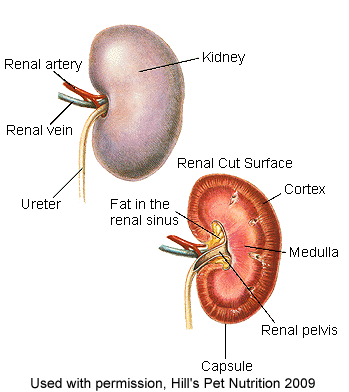
Dogs and cats have two kidneys. These organs lie within the abdomen along side of the spine. The kidneys are essential filters that remove toxins and wastes from the blood. Kidneys produce a hormone that stimulates the bone marrow to make red blood cells. They also maintain the correct balance of water, various salts and minerals in the body. Each kidney is connected to the urinary bladder by a ureter, a tube for transport of urine.
Kidney function
The kidneys have small filters that remove waste from the blood stream. About 20% of the total blood that is pumped out of the heart goes directly to the kidneys. The kidneys produce a hormone called erythropoietin that directly stimulates the bone marrow to produce red blood cells. Failing kidneys, therefore may cause anemia. The kidneys also regulate the amount of electrolytes (salts) such as sodium, potassium and calcium that is contained in the body. The pH of the body is also controlled by the kidneys via the excretion or retention of acids. They also control the amount of water that is excreted in the urine, thus helping to prevent dehydration of the body. A dog, cat and many other species live a normal life with only one kidney. In fact, they can live fairly normally with slightly more than two-third’s of one kidney.

Kidney tumors
Two types of kidney tumors exist: ones that originate from within the kidney and ones that have spread to the kidney from another tumor within the body. Tumors that originate within the kidney include renal carcinoma, renal adenocarcinomas, transitional cell carcinoma, sarcomas of varying types and a tumor that originates from embryonic cells called a nephroblastoma. At the time of diagnosis of a kidney tumor, about 16% of them have evidence of spread of the tumor to the lungs.
Signs
Breeds most common to develop kidney tumors include Cocker Spaniels, Labrador Retrievers, Rottweilers, Golden Retrievers, German Shepherds, Miniature Poodles, Malamute, Springer Spaniel, and Shetland Sheepdogs. Male dogs develop this tumor about 50% more commonly than female dogs and the average age of affected pets is 8.4 years. Patients with nephroblastomas tend to be much younger. Most common clinical signs in affected patients include bloody urine, a palpable abdominal mass, increased thirst, increased urination, lethargy, weight loss, vomiting, pain and behavioral changes.
Diagnosis
The diagnosis of a kidney mass is made on abdominal x-rays or abdominal ultrasound. Advanced imaging such as abdominal MRI or CT scan can be used to define the extent of the kidney tumor, but also may be used to determine if metastasis is also present. Chest x-rays are essential to rule out the presence of metastasis to the lungs and lymph nodes within the chest. Blood work and urine testing is done to ensure that the unaffected kidney is functioning normally and other internal organs are healthy.
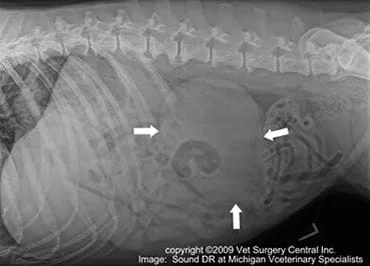
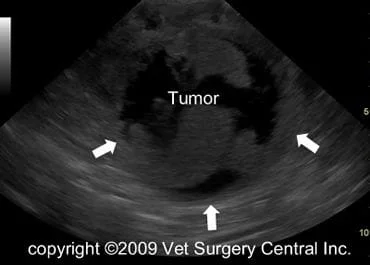
The day of surgery
Our anesthesia and surgical team will prescribe a pain management program, both during and after surgery that will keep your companion comfortable. This will include a combination of general anesthesia, injectable analgesics, epidural analgesia, oral analgesics and anti-inflammatory medication.
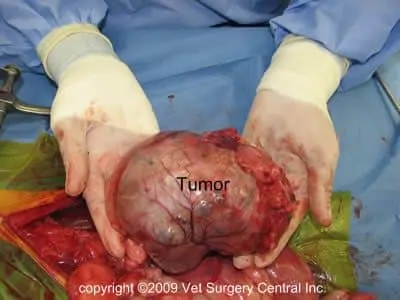
Nephrectomy or surgical removal of a kidney is the best treatment for a kidney tumor, providing that the patient is not in kidney failure. An incision is made along the abdomen to expose the internal organs. The blood vessels and ureters of the affected kidney are tied off and the kidney is then removed. While in our hospital, your companion will continue to receive intravenous fluids, electrolytes and in some cases plasma or an artificial plasma product called Hetastarch. Uncommonly, a blood transfusion may be necessary. Your companion will be carefully monitored in the intensive care and will be given narcotics to ensure a pain-free recovery. Most patients that have abdominal surgery leave our hospital within 24 to 72 hours.
Aftercare
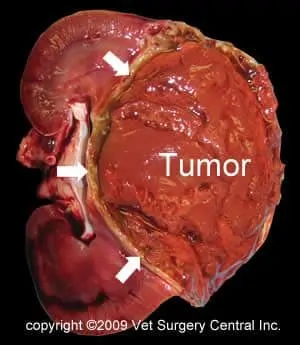
Results
Renal cell carcinoma (renal carcinoma) is the most common primary renal tumor in felines and canines. These tumors have aggressive malignancies with the potential for widespread metastasis in 50-70 percent of canine cases. This tumor commonly spreads to lung, liver, and regional lymph nodes. Reported survival ranges in dogs are variable, depending on the study, with a median of 16 months.
Metastasis at the time of diagnosis correlates with decreased overall survival time (Carvalho, 2017). However, dogs who do not have evidence of metastasis at the time of nephrectomy may have prolonged survival times of up to 4 years or longer (Bryan, 2006).
The mitotic count and histologic subtype of renal cell carcinoma has been shown to have prognostic significance in dogs (Edmonson, 2015). Mitotic count correlates with median survival time with a mitotic count of less than 10 = 1184 days, between 10-30 = 452 days, and greater than 30 = 187 days. Clear cell carcinomas are associated with a greatly decreased median survival time compared to other types of renal cell carcinomas.
Patients that received chemotherapy survived a few months longer than patients receiving only surgery, however this was not found to be statistically significant. At the time of death of affected patients, 77% had evidence of spread of the tumor, in spite of treatments given to the patient.
In cats, the incidence of metastasis at the time of diagnosis was reported to be 64% for renal carcinomas and 100% for transitional cell carcinomas. Seemingly, the prognosis may be poorer for cats that have kidney tumors than dogs.
References
1. Bryan JN et al. Primary Renal neoplasia of Dogs. J Vet Intern med 2006; 20:1155-1160.
2 . Seaman RL, et al. Treatment of renal nephroblastoma in an adult dog. J Am Anim Hosp Assoc 2003;39:76-79.
3. Henry CJ, et al. Primary renal tumours in cats: 19 cases (1992-1998) J Fel Med and Surg 1999;1:165-170.
4. Carvalho S et al. Retrospective evaluation of Cox-2 expression, histological and clinical factors as prognostic indicators in dogs with renal cell carcinomas undergoing nephrectomy. Vet Comp Oncol 2017; 15(4):1280-1294.
5. Edmonson EF et al. Prognostic significance of histologic features in canine renal cell carcinomas: 70 nephrectomies. Vet Pathol 2015; 52(2):260-8.
6. Meuten, ed. Tumors in Domestic Animals 2017, 5th ed., 638-643.


